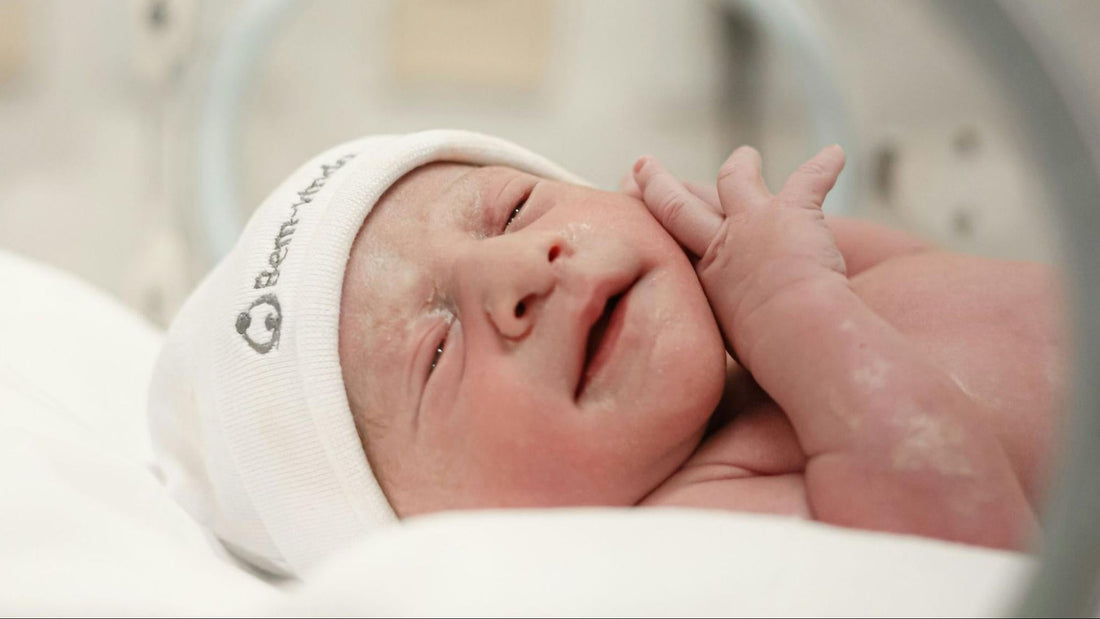
Benefits of Vernix Caseosa for Newborns
Share
When a baby is born, they’re covered in a white coating called vernix caseosa. Often referred to as vernix, it’s a remarkable substance that plays an essential role in protecting your baby in the womb and beyond.
Understanding the benefits of vernix caseosa can help you make confident choices about your newborn’s skin care in those first precious days.
What Is Vernix Caseosa?

Vernix caseosa is a waxy layer made up of water, lipids, and proteins that coats a baby’s skin in the womb. Its name comes from Latin, meaning “varnish of cheese.”
Vernix serves as nature’s moisturizer, barrier, and immune support system, all wrapped into one.
Vernix Benefits for Babies
Research continues to reveal just how powerful vernix is. Here are some of the key benefits of the vernix caseosa function:
- Moisture barrier: Vernix protects delicate newborn skin from amniotic fluid, preventing it from becoming overly wrinkled or waterlogged before birth.
-
Natural moisturizer: With its unique blend of lipids, vernix hydrates the skin and helps prevent dryness after delivery.
- Immune defense: Vernix contains antimicrobial peptides that guard against bacteria, supporting a baby’s developing immune system.
- Microbiome support: Vernix helps seed and protect the skin microbiome, the community of beneficial bacteria that lies the foundation for lifelong skin health.
- Gentle transition: Babies born with lots of vernix often have skin that looks more supple and less irritated, while babies born without vernix may need extra moisturizing care in those early days.
Should You Wash Vernix Off?

One of the most common questions parents ask is: when should you wash vernix off? The short answer—there’s no rush. The World Health Organization recommends delaying your baby’s first bath for at least 24 hours, and many experts suggest gently wiping only what’s necessary.
Allowing vernix to absorb into your baby’s skin maximizes its protective benefits, including temperature control, reducing risk of infection, and even helping to stabilize blood sugar. Not bad for cheese varnish!
If your baby is born with lots of vernix (you’ve probably seen pictures of babies born with lots of vernix online), consider it a gift. That creamy layer is nature’s skin care at its finest. However, don’t be concerned if your baby doesn’t have a thick vernix layer. This is especially common for babies carried to full term because it's already been absorbed.
Caring for Skin After Vernix Wears Off
Eventually, vernix will be absorbed or washed away, leaving your baby’s skin more exposed. At this stage, gentle care is key:
-
Skip harsh soaps: They can strip away natural oils and disrupt the microbiome.
- Use minimal-ingredient products: Look for formulas that are certified Microbiome Friendly and safe for newborns.
-
Moisturize wisely: Products with nourishing oils like olive oil, sunflower oil, and beeswax provide barrier support without unnecessary additives.
At NOLEO, we believe in protecting the natural balance of your baby’s skin. That’s why our 3-in-1 Diaper Care was formulated with your baby’s microbiome in mind. Certified Microbiome-Friendly for infant skin by MyMicrobiome, it’s a gentle yet effective solution that can be used as a diaper cream, lotion, and cleansing cream — replacing wet wipes and harsh cleansers with one safe, simple product.
